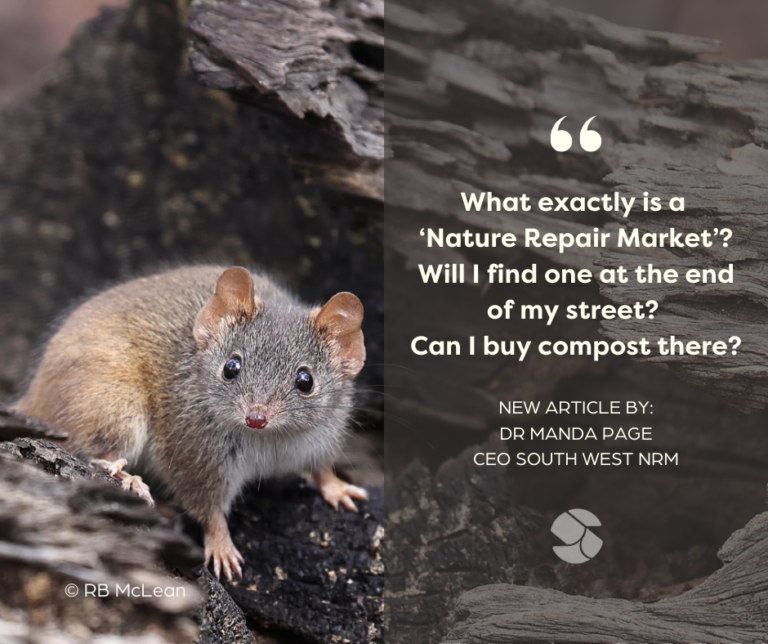
Article by Dr Manda Page
It’s a sad truth that Australia leads the world in species extinction and some aspects of environmental decline. But the planned arrival in 2025 of a Nature Repair Market from the Australian Government aims to leapfrog us to the global forefront of harnessing private money for delivering environmental good.
This is the second instalment in my two-part article series designed to help everyone wrap their heads around the chatter and noise about a nature positive world.
What exactly is a ‘Nature Repair Market’? Will I find one at the end of my street? Can I buy compost there?
I’m also hoping to provide a bit of clear language around all these abstract concepts like ‘biodiversity credits’ and ‘carbon credits’.
In my mind, information is power and if we are to bridge the current gigantuous gap between the environmental and climate targets Australia has set for itself (nationally and internationally) AND the financial investment needed to get there, we all need to – at a minimum – have a good understanding of the concepts involved.
In the previous article I hopefully provided some clarity on the concepts of ‘Nature Positive’ and ‘Net Zero’. If you missed it, you can get up to speed here.
In this article I’m tackling the Nature Repair Market but before we dive into that, there’s some related concepts we need to look at first.
Buzz words #3: Biodiversity Credits
Creating a ‘market’ for something means having a product you can sell. Like a kilo of spuds or a jar of jam. A Biodiversity Credit aims to turn nature into quantifiable units of measure that we can buy and sell.
Private businesses are increasingly compelled to offset the environmental impacts of their work while also seeking to create an edge for themselves by presenting as good corporate citizens. So the idea is that Biodiversity Credits fulfill that need by creating a mechanism and an incentive for businesses to invest in nature.
Businesses who undertake conservation work – like planting a heap of trees – can be financially rewarded for their efforts with Biodiversity Credits. Who would want to buy their credits you’re wondering? Well, other companies also wanting to invest in nature.
Clearly though, converting something as complex as biodiversity into something you can just weigh like a bag of spuds is a real challenge. US journalist Warren Cornwall described it as “like trying to buy a bag of peace”.
The Australian Government has partnered with technical experts and organisations like the CSIRO to nut out how exactly Biodiversity Credits will operate in our new Nature Repair Market so watch this space.
Buzz words #4: Carbon Credits
The concept of Carbon Credits has been around a bit longer than Biodiversity Credits as part of Australia’s existing Carbon Credits Scheme. Its aim was more specifically targeted at projects to reduce carbon in the atmosphere.
Back in 2022, South West NRM assisted with some pilot carbon projects in our region to test the concept. You can read about them here. And in December, WA Agriculture Minister visited us to announce a series of grants for new carbon farming projects we helped develop.
Carbon Credits are a bit simpler to quantify and are tied to a quantity of carbon or carbon dioxide – A calculation around how much your conservation project is expected to reduce carbon emissions by determines how many credits you earn. It still took quite a while to get that one right and biodiversity is far more complex.
Buzz words #4: Nature Repair Market
The Nature Repair Act 2023 came into effect on 15 December, 2023 and was the first step in creating a legislated, national and voluntary biodiversity market where Biodiversity Credits can be earned, bought and sold.
Since that time, the Department of Climate Change, Energy and Environment has been working to create the supporting framework and methods that convert the law into an actual market that works.
According to the DCCEEW website:
The Nature Repair Market scheme is a government initiative that incentivises actions to restore and protect the environment. It encourages nature positive land management practices that deliver improved biodiversity outcomes. The scheme establishes a marketplace where individuals and organisations can undertake nature repair projects to generate a tradable certificate.
These projects could include:
- re-establishing vegetation along waterways
- keeping pests and feral species from destroying native species and ecosystems.
Those eligible to take part might include:
- First Nations people and organisations
- conservation groups like South West NRM
- farmers.
Projects can be undertaken on Australian land and waters, or a combination of both.
What now?
For South West NRM, we are waiting in anticipation for the new Nature Repair Market to arrive.
As a not-for-profit and charity, there is great potential through the Nature Repair Market to generate new funding streams for delivering the environmental conservation work we have been undertaking in our South West over the past 20 years. How exactly that looks, still feels a little fuzzy.
This is new territory for us and our community. We are trying to feel optimistic instead of overwhelmed.
We (and we hope you too) will take some comfort in knowing that the result of all this work should be that our natural resources are more valued, protected and restored for the benefit of current and future generations.
Even if you don’t work directly in the environmental conservation space like our team, you can still play a part by staying informed and sharing credible information within your networks.
Please feel free to share this article within your circles and consider signing up to receive our monthly e-newsletter for further learnings.
For more information on environmental conservation work by South West NRM over 20 years, please visit the Environmental Conservation page of our website.
Previous articles by Dr Manda Page are below.
